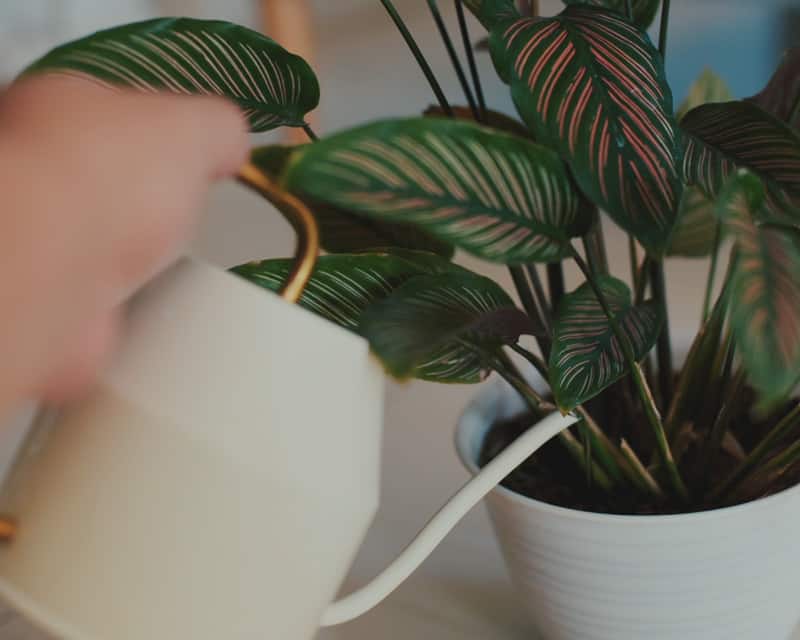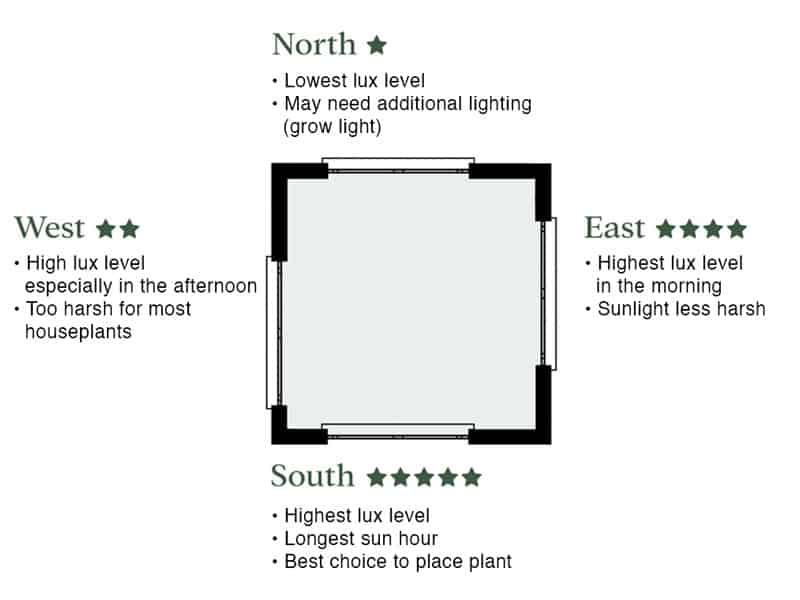
Calathea is a beautiful plant, but it requires extra care to maintain its appearance. Often times you’ll notice that the leaves may start to curl.
Calathea leaves curl in response to dehydration and is a defence mechanism to reduce transpiration rate and avoid further water loss. This condition is often caused by underwatering, low humidity, high temperatures, and root rot from overwatering, disease, and overfertilizing.
In this article, I will discuss the signs that can indicate specific causes of leaf curl and how to treat them properly
Let’s get started
Causes of Calathea Leaf Curling
Many factors could contribute to leaves curling. However, new plant parents often struggle to identify the underlying cause of curled leaves.
You will need to watch for other signs that indicate what may be causing the problem before trying to treat it.
Underwatering – The Most Common Reason of Calathea Curled Leaves
When was the last time you watered your Calathea? If you can’t remember the last time that you watered your Calathea, chances are it’s been too long already and your plant is already thirsty.
Remember, when Calathea is dehydrated, it will activate its defense mechanism to avoid further water loss from transpiration. The leaves will curl inward in response to reduce the surface area from which moisture escapes.
Signs the leaves curling is due to underwatering:
- Check for droopy leaves with yellowing and browning on your Calathea.
- Check the soil moisture level in your pot by placing a soil meter probe halfway down and looking at its reading. If it reads below 3, the plant has not been sufficiently watered.
How to fix underwatered Calathea:
- Give it plenty of distilled or filtered water until you see the water draining from the holes in the bottom.
- Calathea plants need to be watered at least once a week or when the top 2 inches of the soil is dry. Make sure to set a weekly watering schedule on your phone alarm so you do not forget.
Overwatering

Let me tell you a secret, I used to water my Calathea almost every day when I first bought it. I thought that the more water it gets, the faster it will grow a new leaf. I couldn’t have been more wrong!
Overwatering your plant will waterlog its roots which cause root rot. This leads to dehydration because the roots are damaged and can no longer absorb nutrients or water.
Signs of Calathea leaves curling due to overwatering:
- Browning on the tips of the leaves is the first indication of overwatering on Calathea
- The soil will have a strong, unpleasant odor– often a clear sign of root rot
- If you find that your soil is still wet after more than a week or two, it usually indicates the lack of adequate drainage and overwatering.
How to fix overwatered Calathea:
- Wet soil can cause your plant’s leaves to curl. Make sure you allow time for the top 2 inches of the soil to dry before watering again.
- If the soil hasn’t dried up within two weeks, repot your Calathea to a new pot with fresh soil. Mixcoarse materials – such as shredded bark, perlite, or even fine gravel – into the potting soil to create better aeration and drainage.
- Make sure your pot has a drainage hole designed to drain excess water.
Watering with Hard Water
Tap water is usually considered safe for houseplants, but if your city water supply has hard water containing salts, fluoride, and calcium carbonate, it could be harmful to your Calathea.
Fluorine can adversely affect plants at concentrations as low as .1 part per million. In some municipal water supplies, 10 times that amount is added to prevent tooth decay.
Penn State News
Fluoride accumulation on Calathea leaves tissue will inhibit photosynthesis and cause tissue damage. While salts and calcium carbonate that builds up near the roots will cause water to flow from the plant’s root back into the soil.
Eventually, the lack of water supply triggers the plant’s defense mechanism cause leaves to curl up to limit water loss.
Signs of curling leaves due to hard water:
- Leaves turn dry and brittle with yellowing or browning of the tips is a sign of fluoride poisoning in Calathea plants.
- Hard water leaves a white chalky residue on the leaves, stems, and even soil as it evaporates.
How to fix the effect of hard water:
- If the soil has accumulated too much salt, it is best to repot your Calathea to new fresh soil.
- When watering your Calathea, use either distilled water, filtered water, or rainwater.
Low Humidity
Here is a little reminder from the high school science lesson—water flows from places with higher to lower humidity levels.
As the relative humidity drops below 50%, the transpiration rate in Calathea can increase significantly, leading to an excessive water loss and curling of the leaves.
Signs of curled Calathea leaves caused by low humidity:
- It can be hard to separate the signs of low humidity from underwatering as both of them lead to drooping, browning crispy leaves.
- You can accurately measure your humidity level by investing in a hygrometer.
How to fix low humidity levels:
- The Calathea type is sensitive to low humidity levels, so you should strive for at least 60% relative humidity when the plant is actively growing.
- To increase humidity, you can use a plant humidifier or pebble tray.
- You may also want to group your plants together so that they can help create and distribute a humid microclimate growing area.
Direct Sunlight & Heat Stress
Similarly, water moisture also evaporates more quickly when the temperature is high. As a result, the plant’s leaves will begin to curl as a way to reduce water loss.
In addition, excessive exposure to direct sunlight causes concentrated heat on the leaves which increases the rate of transpiration.
Signs to identify curling caused by direct sunlight and heat stress:
- If your Calathea leaves are curling inward and browning on the tips, it is probably because of sunburn.
- Check your temperature and make sure it is between 65°F-80°F (18°C to 27°C) for optimal growing conditions when it comes to Calathea.
How to fix
- Place Calathea indoors during cold winter and hot summer months to keep it at an ideal temperature with the help of a heater and air-conditioning.
- You should also find a shaded east-south facing window in a room that is exposed to indirect filtered sunlight for your Calathea to thrive.

Overfeeding with Fertilizer
I used to think that the more fertilizing my houseplant received, the healthier and happier it would be. But here’s the thing:
Over-fertilization can cause the soil to become oversaturated with salts around the roots, which causes water moisture to be drawn out of plants rather than be absorbed.
This lack of water will dehydrate the plant and cause it to curl up. While it can be remedied, if left unchecked, salt buildup in the soil will eventually cause root burn damage and kill your Calathea.
Signs of curled leaves due to over-fertilization:
- If you use too much fertilizer, you will notice a crusty build-up on the edges of your pots or on the surface of the soil.
- Yellowing and wilting of lower leaves, together with browning on the leaf margins and tips signify that you have over-fertilized your Calathea.
- If you notice the above signs, then inspect the plant root to check for black brown or rotting roots that usually occur due to over fertilization.
Fixing over-fertilize Calathea curled leaves:
- First, remove the Calathea from the soil and cut off any rotten roots. Then, fill a new pot with fresh soil and repot the Calathea.
- In the future, use half the dose recommended on fertilizer packaging and no more than once per month.
Pest Infestation
We’ve all been there, we bought a new plant, but within days, we noticed tiny bugs crawling around our plant collection!
Spider mites are the most common pest that feeds on Calathea plant tissues and sap. These pests can cause disfigurement and curling of the leaves.
Signs of pest infestation:
- Spider mites are difficult to spot, but wrinkled and dry leaves with webbing along the underside can be an indication of them.
How to eradicate these pests:
- Apply neem oil to the infected area to temporarily repel these insects.
- Clean both sides of foliage with a cotton pad or cloth dipped in a light mixture of water and dish soap to completely remove the pests.
- Regularly wiping your Calathea leaves will help you to spot any pest infestation early
In conclusion:
The main cause of a Calathea plant curling up is usually dehydration, but the condition can be caused by numerous possibilities. So, It is important for you to properly care for and provide your Calathea with an appropriate environment.
Hope this article helps!

